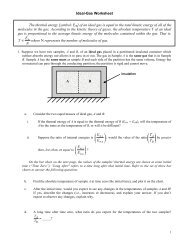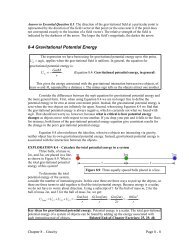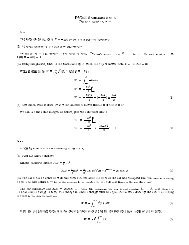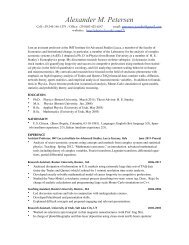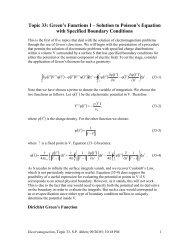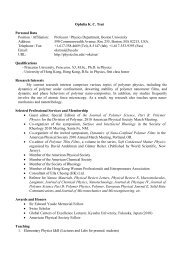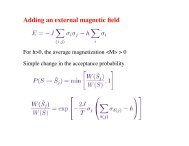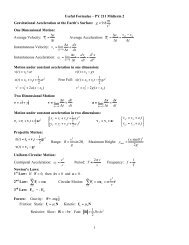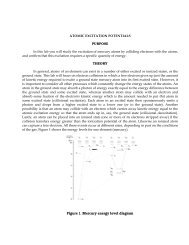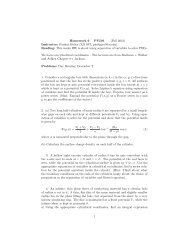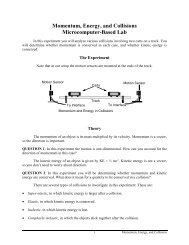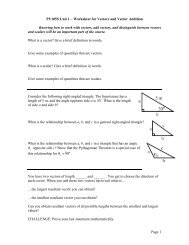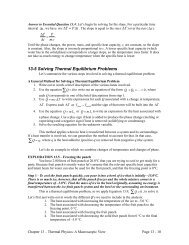Essential Physics, Answers to selected Chapter 7 Problems Page 1 ...
Essential Physics, Answers to selected Chapter 7 Problems Page 1 ...
Essential Physics, Answers to selected Chapter 7 Problems Page 1 ...
Create successful ePaper yourself
Turn your PDF publications into a flip-book with our unique Google optimized e-Paper software.
<strong>Answers</strong> <strong>to</strong> <strong>selected</strong> problems from <strong>Essential</strong> <strong>Physics</strong>, <strong>Chapter</strong> 7<br />
1. It is more tiring <strong>to</strong> walk uphill for an hour than it is <strong>to</strong> walk over level ground,<br />
because when you walk uphill you are doing work against gravity.<br />
3. The kinetic energy comes from the gravitational potential energy of the snow or mud,<br />
s<strong>to</strong>red in the position of the snow or mud high up at the <strong>to</strong>p of the slope.<br />
5. The speeds are equal in cases B and C, and smaller in case A. The final kinetic energy<br />
is equal <strong>to</strong> the initial kinetic energy (which is zero in case A and equal <strong>to</strong> the same nonzero<br />
value in cases B and C) plus the difference in gravitational potential energy between<br />
the initial and final positions.<br />
7. (a) Mechanical energy is not conserved. The rock does work on the can, crushing it.<br />
The rock’s mechanical energy gets transformed in<strong>to</strong> other forms of energy, such as<br />
thermal energy and sound energy. (b) Energy is conserved in this process. This is<br />
consistent with the law of conservation of energy. If you account for all the different<br />
forms of energy before and after the crushing of the can, there is the same <strong>to</strong>tal amount of<br />
energy beforehand and afterwards.<br />
9. (a) (b) (c)<br />
11. The energy is s<strong>to</strong>red temporarily in the spring. The more the spring is compressed,<br />
the more energy is s<strong>to</strong>red in it. So, as the block compresses the spring, the spring slows<br />
down, and the block’s kinetic energy is transformed in<strong>to</strong> potential energy in the spring.<br />
After the block comes momentarily <strong>to</strong> rest, the spring pushes on the block, transforming<br />
the potential energy back in<strong>to</strong> the block’s kinetic energy.<br />
13. (a) 4.95 m/s (b) The ball reaches its maximum speed when it passes through its<br />
lowest point, immediately below the hook. (c) Because of energy conservation, the ball<br />
goes <strong>to</strong> 1.25 m higher than the equilibrium position. (d) The only numerical value we<br />
need is the vertical distance that the ball starts above equilibrium. The mass cancels out<br />
of the energy equation, and the string length is not needed.<br />
15. (a) This is a reasonable assumption. A typical observation is that, in one swing, the<br />
ball reaches almost the same vertical position on one side that it started from on the other,<br />
meaning that only a small fraction of the ball’s mechanical energy is removed in one<br />
swing. (b) After many swings, the ball comes <strong>to</strong> rest. All of the initial gravitational<br />
potential energy is converted <strong>to</strong> thermal energy because of the negative work done on the<br />
ball by the resistive forces. This work is negative because the resistive forces always<br />
oppose the ball’s motion. (c) –2.45 J<br />
<strong>Essential</strong> <strong>Physics</strong>, <strong>Answers</strong> <strong>to</strong> <strong>selected</strong> <strong>Chapter</strong> 7 <strong>Problems</strong> <strong>Page</strong> 1
17.<br />
(b) Ui + Ki + Wnc = U f + K f<br />
, and define the zero level for<br />
gravitational energy <strong>to</strong> be at the level of the floor.<br />
(c) K i = 0, because the keys start at rest; W nc = 0, because we<br />
assume that air resistance is negligible; U f = 0, because the keys end<br />
up on the floor, which is where we defined the zero for<br />
gravitational potential energy <strong>to</strong> be.<br />
1 2<br />
Our equation thus becomes Ui = Kf ⇒ mgh=<br />
mvf<br />
2<br />
(d) v = 2gh<br />
= 4.8 m/s<br />
f<br />
19.<br />
(b) Ui + Ki + Wnc = U f + K f<br />
, and<br />
define the zero level for gravitational<br />
energy <strong>to</strong> be at the starting point.<br />
(c) K i = 0, because you start from rest; U i = 0, because you start from the zero level for<br />
gravitational potential energy. Let’s also assume that the number given in the problem for<br />
the work represents the net work done by non-conservative forces.<br />
Our equation thus becomes Wnc = U f + Kf ⇒<br />
4 1 2<br />
1.5× 10 J = mgh+<br />
mvf<br />
2<br />
4 1 2<br />
1.5× 10 J − mv f<br />
(d) h = 2 = 22 m<br />
mg<br />
21.<br />
23.<br />
<strong>Essential</strong> <strong>Physics</strong>, <strong>Answers</strong> <strong>to</strong> <strong>selected</strong> <strong>Chapter</strong> 7 <strong>Problems</strong> <strong>Page</strong> 2
25.<br />
(b) m(50 km/h) + M(0) = ( m+ M)(10 km/h) , with the positive direction being the<br />
direction of the car’s velocity before the collision (which is the same direction as the<br />
velocity of the car and the truck after the collision).<br />
(c)<br />
M<br />
m(50 km/h) − m(10 km/h)<br />
= = 4m=<br />
8000 kg<br />
10 km/h<br />
27.<br />
(b) Let’s define left as the positive direction, because the net momentum of the system is<br />
in that direction:<br />
!mv + 2mv = mv Af<br />
+ mv Bf<br />
v = v Af<br />
+ v Bf<br />
(c) v − v = v − v =− 3v<br />
Bf Af Ai Bi<br />
(d) 2v Bf<br />
= !2v " v Bf<br />
= !v v Af<br />
= +2v<br />
Puck B is moving <strong>to</strong> the right after the collision, and puck A is moving left after the<br />
collision.<br />
29. (a)<br />
(b)<br />
Cue ball (initial) 8-ball (initial) Cue ball (final) 8-ball (final)<br />
x-direction m× 1.0 m/s 0 m× (0.70 m/s)cos(42 ° ) mv f cosθ<br />
= m×<br />
0.520 m/s<br />
y-direction 0 0 m× (0.70 m/s)sin (42 ° ) – mv f sinθ<br />
= m×<br />
0.468<br />
<strong>Essential</strong> <strong>Physics</strong>, <strong>Answers</strong> <strong>to</strong> <strong>selected</strong> <strong>Chapter</strong> 7 <strong>Problems</strong> <strong>Page</strong> 3
(c) From the y-direction, mv sinθ<br />
= m× 0.468 m/s ⇒ v sinθ<br />
= 0.468 m/s<br />
f<br />
From the x-direction, mv cosθ<br />
= m× 0.480 m/s ⇒ v cosθ<br />
= 0.480 m/s<br />
f<br />
0.468<br />
Dividing one equation by the other gives tanθ<br />
= ⇒ θ = 44.3°<br />
0.480<br />
Solving for v f gives v f cosθ = 0.67 m/s .<br />
The velocity of the 8-ball after the collision is 0.67 m/s at an angle of 44° from the<br />
direction of the cue ball’s velocity before the collision.<br />
31. (a) v2 = 2µ<br />
gd = 1.0 m/s (b) h = 0.293 m; v 1 = 2gh<br />
= 2.42 m/s;<br />
1f 1i 2f<br />
f<br />
K<br />
v = v − 2v<br />
= 0.42 m/s, in the same direction as the ball’s velocity just before the<br />
collision.<br />
10<br />
33. (a) 4× 10 J (b) For such a large object going that fast, neglecting air resistance is<br />
probably not a good idea. If air resistance could be neglected, the plane’s engines could<br />
be switched off after reaching cruising altitude and the plane would continue at constant<br />
velocity after that. So, the energy is a good deal larger than the value we calculated in (a).<br />
35. (a) Because mechanical energy (the sum of the potential and kinetic energies) is<br />
conserved in this situation, the mechanical energy at the beginning, at the lowest point,<br />
and in the final situation are all the same, so we can relate the energy at the beginning <strong>to</strong><br />
the energy at the end. (b)<br />
v f<br />
= 2gh<br />
= 2 × (9.8 m/s ) × (1.0 m) = 4.4 m/s<br />
37. (a) There must be a kinetic force of friction acting on the box. If there was no friction<br />
force, the box’s speed would increase as it went down the incline. The kinetic force of<br />
friction must exactly balance the component of the force of gravity that acts down the<br />
slope. (b) µ Kmg<br />
cosθ = mg sinθ ⇒ µ K = tanθ<br />
= 0.75 (c) We don’t need <strong>to</strong> know<br />
either the mass or the speed. The mass cancels out of the equation, and all we need <strong>to</strong><br />
know about the velocity is that it is constant – the exact value does not matter.<br />
39. (a)<br />
2 2<br />
v= 2gh<br />
= 16 m /s = 4.0 m/s<br />
2 2<br />
1 ⎛<br />
2<br />
v ⎞<br />
f<br />
⎛(3.0 m/s)<br />
2<br />
⎞<br />
(b) Wnc<br />
= mv f − mgh = m − gh<br />
= (0.050 kg) −(10 m/s )(0.8 m)<br />
2 ⎜<br />
⎜ ⎟<br />
2 ⎟<br />
⎝ ⎠<br />
⎝ 2<br />
⎠<br />
W nc =− 0.175 J<br />
(c) The work done by air resistance is negative, which makes sense because the force<br />
of air resistance is opposite in direction <strong>to</strong> the ball’s displacement.<br />
41. The motion would be similar, it would just happen more slowly than it would on the<br />
Earth. On the Moon, the block would reach the same positions on either side that it did on<br />
the Earth, and it would s<strong>to</strong>p in the same place that it did on the Earth, but the speed<br />
during the motion would be smaller on the Moon than it is on the Earth.<br />
i<br />
2<br />
f<br />
f<br />
<strong>Essential</strong> <strong>Physics</strong>, <strong>Answers</strong> <strong>to</strong> <strong>selected</strong> <strong>Chapter</strong> 7 <strong>Problems</strong> <strong>Page</strong> 4
43. For the first block, mgh = K1. For the second block, mgh + Wnc<br />
= 0.8K1<br />
. Combining<br />
these gives W =− 0.2mgh. However, the work done by non-conservative forces is the<br />
nc<br />
work done by the kinetic friction force, which is Wnc =− µ K FN<br />
d, where FN<br />
= mgcosθ<br />
,<br />
and d, the distance moved along the slope, is related <strong>to</strong> h by d = h/ sinθ<br />
. Bringing<br />
everything <strong>to</strong>gether gives:<br />
µ K mgh cosθ<br />
− =− 0.2mgh<br />
which gives tanθ = 1.25 , which gives an angle of 51°.<br />
sinθ<br />
45.<br />
m<br />
B<br />
2<br />
A f A K A<br />
2<br />
g(2.0 m) − 0.5v<br />
f<br />
0.5 mv + mg(2.0 m)sinθ + µ mgcos θ(2.0 m) 36 + 24 + 20<br />
= = = 40 kg<br />
20 −18<br />
1 2<br />
47. (a) Energy conservation: mgh = mvb<br />
+ 2mgR<br />
2<br />
2<br />
mvb<br />
Forces and circular motion: 2mg<br />
=<br />
R<br />
Combining these gives h = 3R.<br />
1 2<br />
(b) Energy conservation: mgh = 3mgR = mv a<br />
2<br />
mv<br />
Forces and circular motion: FN<br />
− mg =<br />
R<br />
Combining these gives F = 7mg<br />
1 2<br />
49. Energy conservation: mgh = mvb<br />
+ 2mgR<br />
2<br />
Forces and circular motion:<br />
Combining these gives h = 2.5R.<br />
N<br />
F<br />
N<br />
2<br />
a<br />
2<br />
mvb<br />
0 mg<br />
= ⇒ =<br />
R<br />
51. (a) 6 m/s <strong>to</strong> the right<br />
(b) The collision is inelastic. One way <strong>to</strong> justify this is <strong>to</strong> work out the elasticity,<br />
which is 0.5 in this case. That is less than 1, implying an inelastic collision. A second<br />
way <strong>to</strong> justify this is <strong>to</strong> work out the kinetic energy before and after the collision. There is<br />
2 2<br />
a lot less kinetic energy in the system after the collision ( m× 80 m /s ) than before<br />
2 2<br />
( m× 200 m /s ), so the collision is inelastic. It is not completely inelastic, because the<br />
two pucks do not stick <strong>to</strong>gether after the collision.<br />
53. 0.5v, directed left<br />
<strong>Essential</strong> <strong>Physics</strong>, <strong>Answers</strong> <strong>to</strong> <strong>selected</strong> <strong>Chapter</strong> 7 <strong>Problems</strong> <strong>Page</strong> 5
55. (a) After the collision, the object of mass 3m is at rest, while the object of mass m is<br />
!2v (b) 4h<br />
57. (a) Before the collision, the Jetta was traveling at 4/3 the speed of the Acura. The<br />
Jetta was traveling faster, in other words.<br />
(b) Carrying out an energy analysis after the collision allows us <strong>to</strong> get a range of<br />
speeds for the cars immediately after the collision: v= µ gd , so this speed is<br />
somewhere between 6.96 m/s and 7.41 m/s. Doing a momentum analysis, we can then<br />
find a range of speeds for the two cars after the collision. The range for the Acura is 8.61<br />
m/s <strong>to</strong> 9.17 m/s, while the range for the Jetta is 11.5 m/s <strong>to</strong> 12.2 m/s. Converting these<br />
values <strong>to</strong> mph gives a range for the Acura of 19.3 mph <strong>to</strong> 20.5 mph and a range for the<br />
Jetta of 25.7 mph <strong>to</strong> 27.4 mph. Thus, the Jetta was clearly speeding, so that driver should<br />
get a speeding ticket. The Acura may or may not have been slightly speeding, so we can’t<br />
really say that driver was entirely blameless. From these results, we can’t say definitively<br />
that the driver of the Jetta was entirely <strong>to</strong> blame.<br />
2 K<br />
59. Yes, the result does match the result we got using the component method.<br />
61. (a) (i) v i /5 (ii) 4 v i /5 (b) 4T and 16D<br />
<strong>Essential</strong> <strong>Physics</strong>, <strong>Answers</strong> <strong>to</strong> <strong>selected</strong> <strong>Chapter</strong> 7 <strong>Problems</strong> <strong>Page</strong> 6


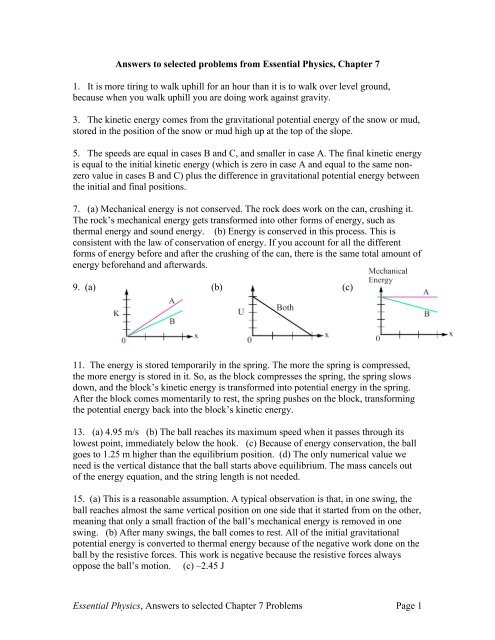
![arXiv:1303.7274v2 [physics.soc-ph] 27 Aug 2013 - Boston University ...](https://img.yumpu.com/51679664/1/190x245/arxiv13037274v2-physicssoc-ph-27-aug-2013-boston-university-.jpg?quality=85)
